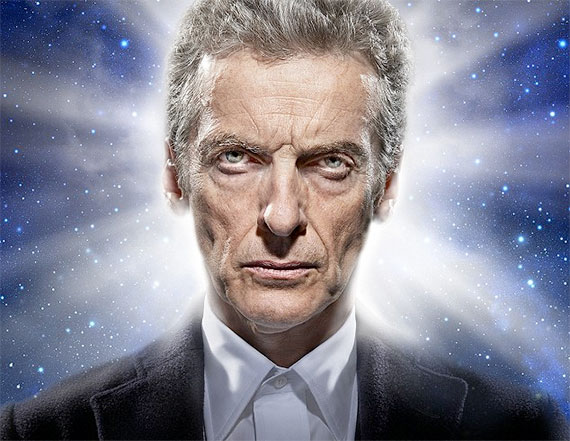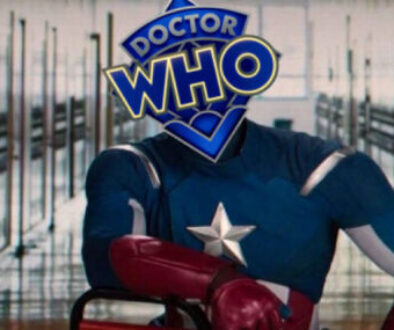Series 8: The Long Regeneration
Guest contributor Zachary Bernstein ponders Moffat’s long game with Capaldi.

There have only been so many regenerations in the show’s 51 year long voyage. Yet, the most recent regenerations have arguably become the most prolific. David Tennant’s regeneration had been alluded to in Planet of the Ood when it aired in 2008, but he didn’t even leave the program until The End of Time Part 2 on New Year’s Day, 2010. Also, Matt Smith’s regeneration came with twists and turns, as the supposed finale of the Silence story arc. So, what is the story with Peter Capaldi’s change?
The issue I bring to the table is with the tone of Series 8, or rather how long it took for there to be a change. Matt Smith instantly dazzled the audience with his fast talk and dashing looks; a complete one-eighty from David Tennant’s term. It had taken much longer for the tone of Series 8 to reach its current Grimm dark fairy tale manner of storytelling. The answer, put simply, is Steven Moffat.
Back in the spring of 2010 when Matt Smith debuted in Series 5 as the time travelling alien, the tone was instantly changed to one which targeted the then current generation of viewers. Social media was afoot in Moffat’s scheme, which ties into advertising for a global appeal. It was hip, it was young, and it was clever. Sounds very much like Moffat, right? Well, we all know about his dark side.
 Moffat loves fear. Whatever transpired in his life to make him so passionate to scare children is beyond my perspective as of now. Undoubtedly, I know that he has many great ideas. Blinking, remembering, touching, all basic aspects of our lives he somehow perverted into the Weeping Angels, the Silence, and gas mask zombies respectively. Others I have found to be less significant, but the point is that Moffat has a flair for the darker side of things. That is where the tone shifted from Matt Smith’s term to Capaldi’s. The transition wasn’t instantaneous, it was slow.
Moffat loves fear. Whatever transpired in his life to make him so passionate to scare children is beyond my perspective as of now. Undoubtedly, I know that he has many great ideas. Blinking, remembering, touching, all basic aspects of our lives he somehow perverted into the Weeping Angels, the Silence, and gas mask zombies respectively. Others I have found to be less significant, but the point is that Moffat has a flair for the darker side of things. That is where the tone shifted from Matt Smith’s term to Capaldi’s. The transition wasn’t instantaneous, it was slow.
We all know that Moffat is a schemer, concocting brilliant long term story arcs. Why, sometimes I even feel the Silence arc was a convoluted excuse to bring back Gallifrey, planned right from day-one with the Eleventh Hour right after The End of Time, picking up where David Tennant’s concluding Gallifrey returns arc left off. Moffat’s design was ingenious, although I could argue it could have been delivered in a more coherent way that paid off all the patience I’ve had with the show. But more of that another time. Either way, I ask myself what Moffat’s scheme is now with Peter Capaldi. I’ve heard whispers of a big cliffhanger for the finale of Series 9, and that’s wonderful.
 I didn’t feel Capaldi was his own Doctor until four or five episodes into Series 8. Now this could all be my conception, granted, but hear me out. Matt Smith drew in the largest fan base the show has ever had, and that fact is due to Steven Moffat targeting the youth of this generation. The show was very friendly to gender concepts and the rise of social media, which characterize current events. December 2013, our attractive young Doctor is replaced with a much older fellow, and a grumpy one at that. It seems like yet another one-eighty, but a distressing one. The initial episodes still felt like Matt Smith episodes, with clever twists and his recognizable mannerisms. The reason for this, I would wager, is all about the fans.
I didn’t feel Capaldi was his own Doctor until four or five episodes into Series 8. Now this could all be my conception, granted, but hear me out. Matt Smith drew in the largest fan base the show has ever had, and that fact is due to Steven Moffat targeting the youth of this generation. The show was very friendly to gender concepts and the rise of social media, which characterize current events. December 2013, our attractive young Doctor is replaced with a much older fellow, and a grumpy one at that. It seems like yet another one-eighty, but a distressing one. The initial episodes still felt like Matt Smith episodes, with clever twists and his recognizable mannerisms. The reason for this, I would wager, is all about the fans.
In order to retain the fans of Matt Smith’s term, there had to be a much more gradual transformation into Capaldi’s term. The sudden shock of a polar opposite character would undoubtedly push away many fans. In order to show that the Twelfth Doctor is still the Doctor, it was necessary to slowly integrate Capaldi’s own traits into the show.
 I noticed the greatest change halfway through the season with Kill the Moon and its cinematography. Throughout the episode, I felt that the setting was incredibly immersive and realistic. This did not look like the low-budget set from the Russell T. Davies era, but something more similar to a video game’s landscape. At the end when our characters stood on the beach and we got a good glimpse of the Moon, I felt much more immersed into the setting than I had from graphics or props from episodes prior. It is in this transformation that I knew we had a new Doctor. This was something original and never before been possible, but the decrease in cost for graphics and increase in ability to produce said graphics results in a more immersive experience.
I noticed the greatest change halfway through the season with Kill the Moon and its cinematography. Throughout the episode, I felt that the setting was incredibly immersive and realistic. This did not look like the low-budget set from the Russell T. Davies era, but something more similar to a video game’s landscape. At the end when our characters stood on the beach and we got a good glimpse of the Moon, I felt much more immersed into the setting than I had from graphics or props from episodes prior. It is in this transformation that I knew we had a new Doctor. This was something original and never before been possible, but the decrease in cost for graphics and increase in ability to produce said graphics results in a more immersive experience.
 My question though, is this: why make Capaldi the Doctor? One answer is in the two perspectives that Steven Moffat is possibly faced with. His first perspective is how he sees the Doctor, the other is how he needs to project that to share with the audience. In order to appeal to the audience, Moffat chose Matt Smith in the beginnings of his show-running era. Along the way we saw more of Moffat’s style, and became familiar with many of the aspects of his writing. However, Moffat might have all along had a darker depiction of the Doctor in mind, much like Christopher Eccleston’s portrayal of post-war trauma. In order to bring to the front a character which better matched his own opinion of the Doctor, Moffat slowly integrated Peter Capaldi. After all, Vastra mentioned in Deep Breath that this was who the Doctor was underneath that young mask. At the beginning of Series 9, the Doctor feels more comfortable being himself. Now that we are post Series 8, I feel that transformation is now complete.
My question though, is this: why make Capaldi the Doctor? One answer is in the two perspectives that Steven Moffat is possibly faced with. His first perspective is how he sees the Doctor, the other is how he needs to project that to share with the audience. In order to appeal to the audience, Moffat chose Matt Smith in the beginnings of his show-running era. Along the way we saw more of Moffat’s style, and became familiar with many of the aspects of his writing. However, Moffat might have all along had a darker depiction of the Doctor in mind, much like Christopher Eccleston’s portrayal of post-war trauma. In order to bring to the front a character which better matched his own opinion of the Doctor, Moffat slowly integrated Peter Capaldi. After all, Vastra mentioned in Deep Breath that this was who the Doctor was underneath that young mask. At the beginning of Series 9, the Doctor feels more comfortable being himself. Now that we are post Series 8, I feel that transformation is now complete.
Series 9 will be Capaldi’s truest season, I hope. It will not be a transition from one unique Doctor’s tenure and living in that memory, but rather a series all its own. I am still faced with trying to understand Moffat’s endgame here. Moffat successfully brought Doctor Who to a global standard, climaxing in the 50th Anniversary episode, which was successfully advertised. I don’t think he’s done making history just yet.
The next Doctor, 13, will be historic. I just have that feeling we may not be looking at a man filling the Doctor’s shoes. A divisive topic to be sure, the prospect of a female Doctor could potentially bring the show to unfound heights. I know this is Peter Capaldi’s time, but as a human being I can’t help but looking ahead, especially when Moffat teases us all the time with potential developments.
The water was tested with Michelle Gomez, and from what I have seen her role was accepted quite well, albeit controversially. That was Moffat gaging the world’s preparedness, to see how fans would feel about a time lord’s gender change. It might have nothing to do with character development, but just like our young Matt Smith, a female Doctor would bring in a group of people previously untargeted as the audience of the show.








